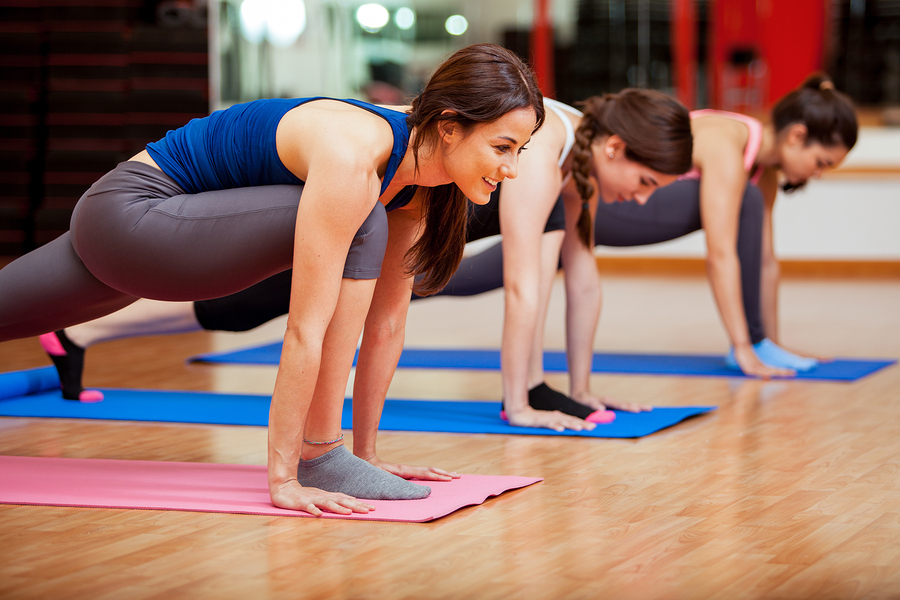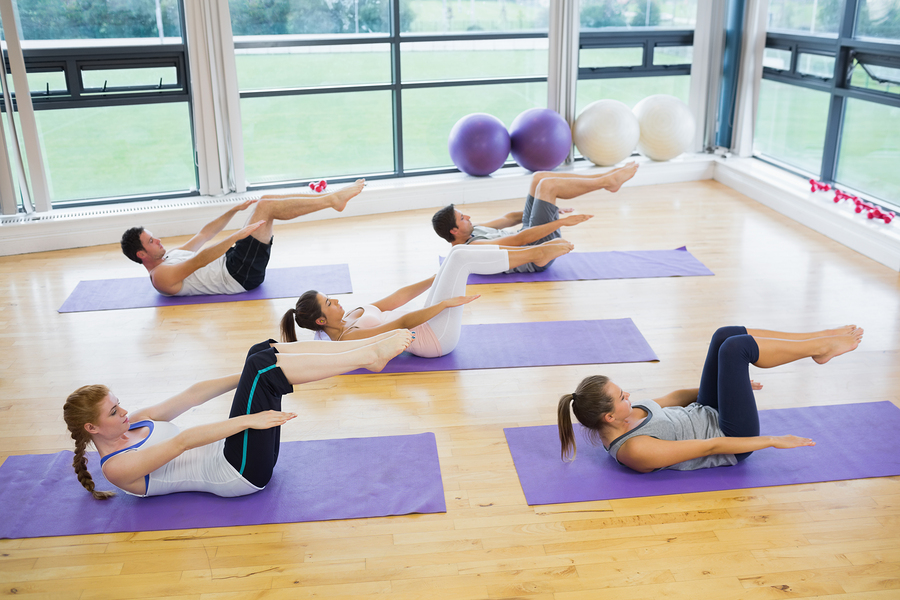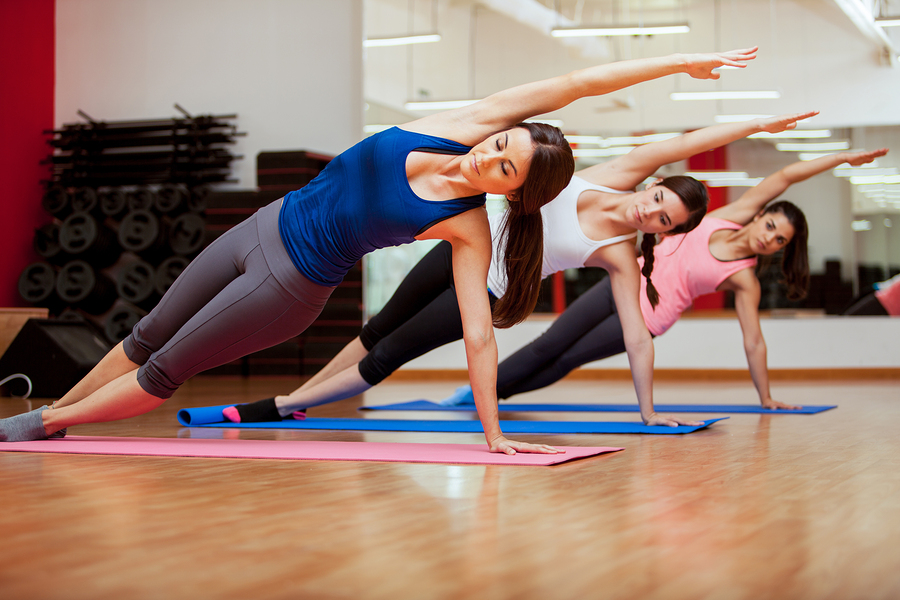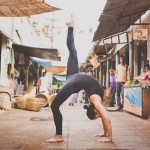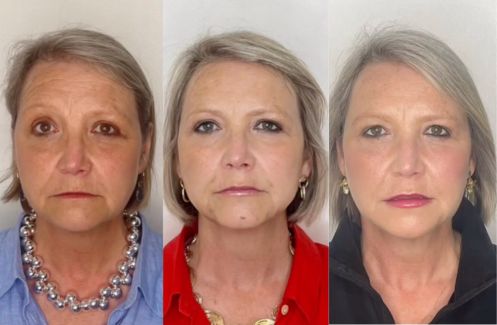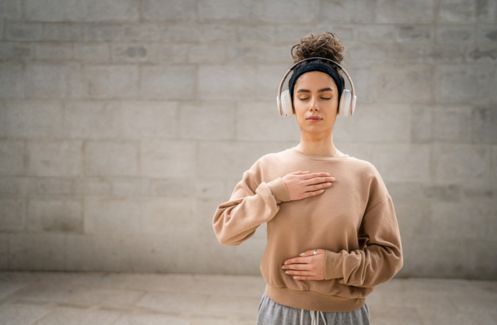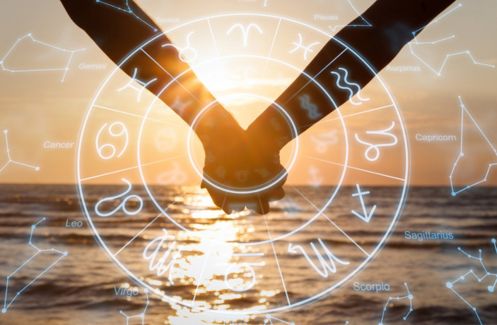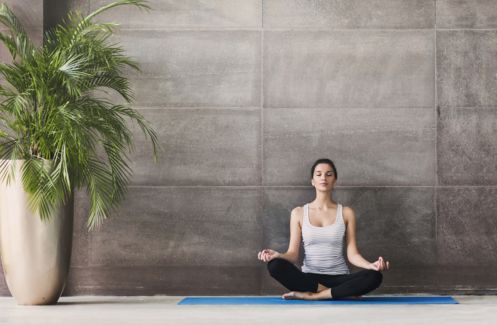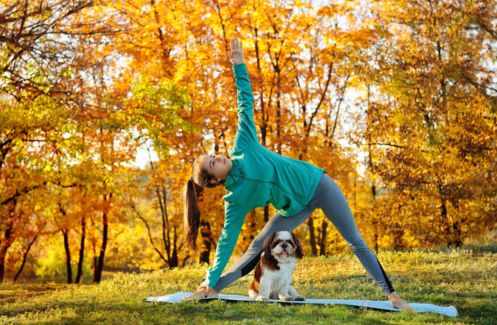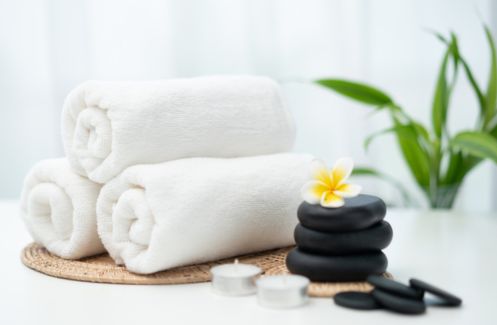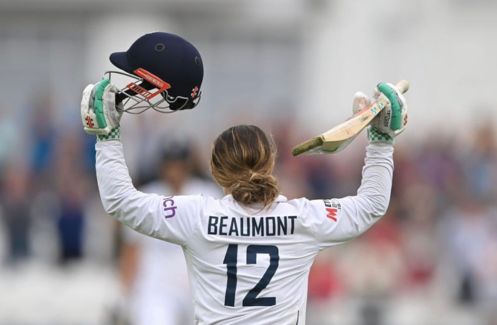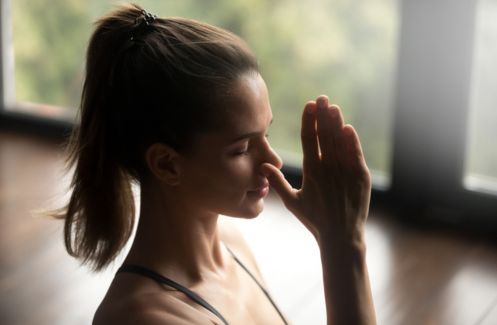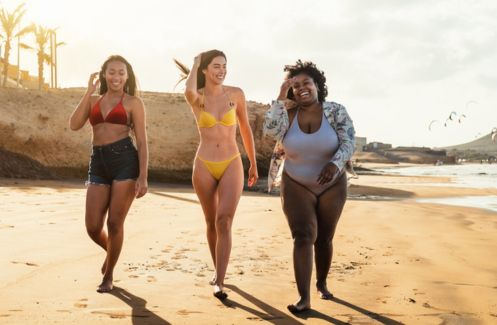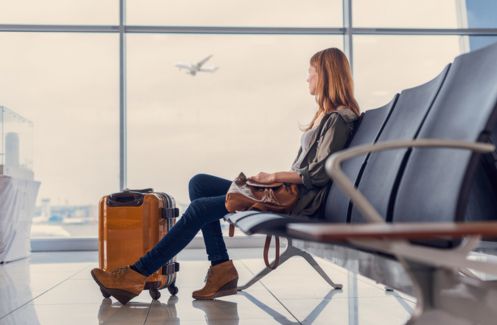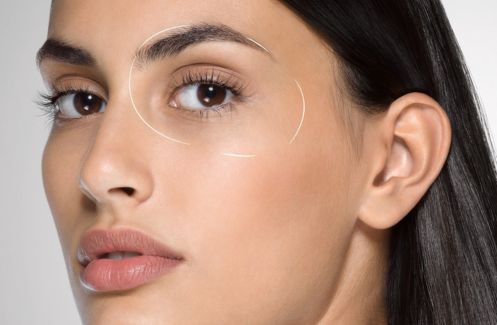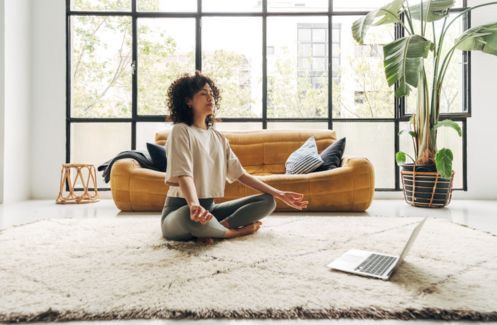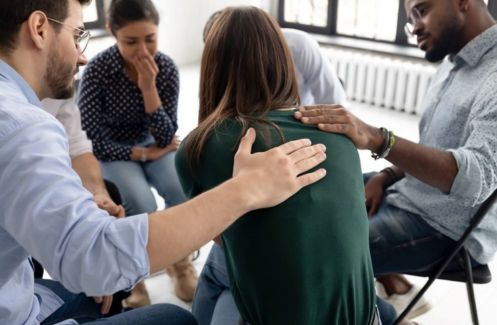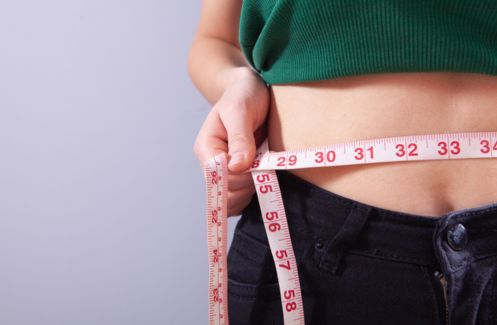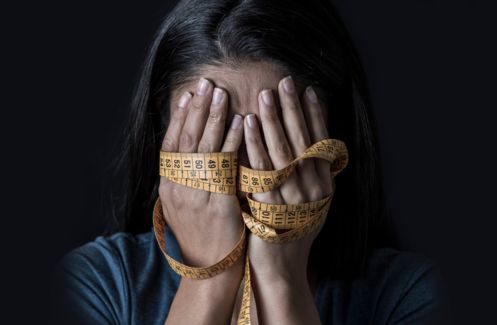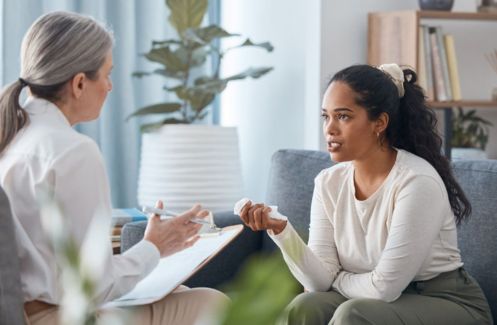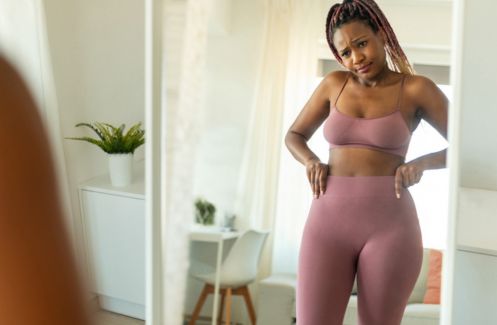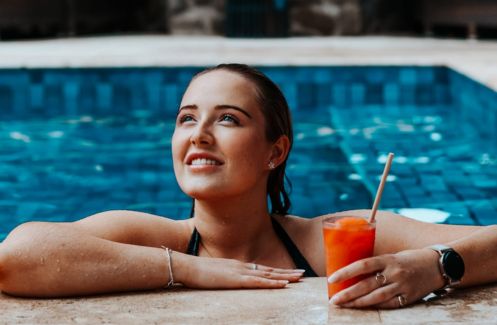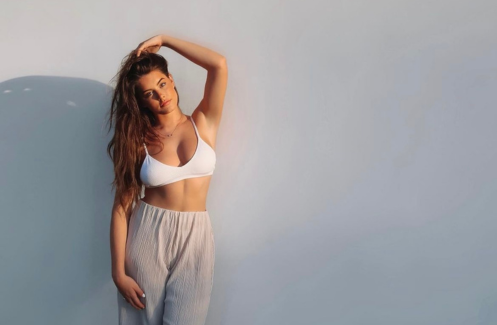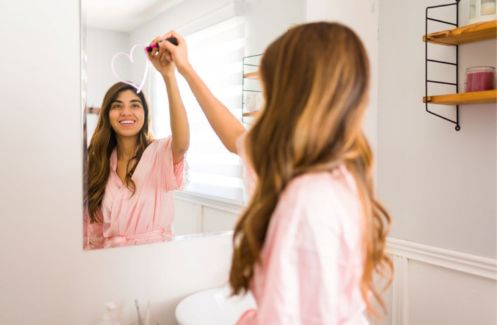Many yoga studios and gyms offer yoga classes classified not only by type (Ashtanga, Vinyasa Flow, Iyengar) but also level – 1, 2 and 3. How do you know what level you’re at? Healthista’s Yoga Girl Genny Wilkinson-Priest explains
It’s a common mistake to assume that a Level 1 class is for ‘stiffies’ and a Level 2 for the more-physically able. It’s much more complicated than that – some people can and do attend Level 1 classes for years, or even their whole life, whether or not they are ‘bendy’. There is so much value to be gained working on foundational postures. Likewise, someone with a background in gymnastics or dance should always – always — start with Level 1 classes. It’s not about your flexibility, it’s about your knowledge and experience of yoga. Just because you can put your leg behind your head doesn’t mean you don’t need to learn the essential points of alignment in Downward Dog, or a connectedness to the body.
All classes, no matter the level, will place an emphasis on using the breath and working mindfully with the body in order to tap into working with the subtleties of the mind. Whether through movement, chanting, mudra (symbolic gestures usually performed with the hand) or bandha (energy locks) work, all levels will lead you to a state of centered calm, and reap the physical and mental rewards of yoga.
Newbies are of course welcome in a Level 1 class, but it’s best to take a 6-week Beginners Course if you are totally new to yoga. You will likely feel more comfortable in a group that doesn’t know their Warrior 1 from their Trikonasana! A beginner’s course assumes no previous knowledge of yoga, where a Level 1 class assumes basic understanding.
Some advanced students like to take a Beginner’s Course as they recognize their practice improves after going back to the basics.
Here’s a breakdown of what to expect, and what not to expect from Level 1, 2 and 3 yoga classes:
LEVEL 1
Level 1 classes guide you slowly through many basic yoga asanas. While it is suitable for beginners, it is also for those working with an injury (tell the teacher first!) and more seasoned practitioners. Many advanced students return again and again to a Level 1 class to work on the finer points of alignment in basic postures – for oftentimes the more advanced asanas (sanskrit for postures) are rooted in the basic ones. Focus will be on safety and alignment, and making the beginner more comfortable and familiar with common yoga postures.
What to expect:
Your teacher will most likely demonstrate the posture, calling it by its Sanskrit name but also giving the English translation so as not to overwhelm any beginners. You can expect a well-rounded class of forward bends, gentle backbends and twists. Modifications will be given (bend your knees in a seated forward bend), and props used (sit bones on a block in Sukhasana – sitting with crossed legs – to tilt the pelvis forward.)
You might also be introduced to postures that prepare you for more intermediate ones – for example, you might work on Dolphin Pose to strengthen and prepare the shoulders for headstands taught in Level 2 or 3 classes. If the class is less busy like in some daytime classes, and the teacher deems it safe to do so, then full headstand might be incrementally taught.
Basic pranayama (conscious manipulation of the breath) and seated meditation might also be explored.
Commonly taught asanas include:
Downward Dog, Virabhadrasana 1 (Warrior 1), Sphinx Pose, Paschimottanasana (Seated forward bend), Vrksasana (Tree Pose), and Ardha Matsyendrasana (Half Lord of the Fishes Pose.)
What not to expect:
Anything that might compromise the integrity of key joints in the body like the knee, neck and lower back. You are unlikely to practice asanas like Urdhva Danurasana (Full Wheel), and Padmasana (Lotus). Some teachers might not teach full Surya Namaskar as each pose within the Sun Salutation is more likely to be separately taught.
Are you ready to advance to Level 2?
It’s a bit tricky to provide benchmarks to know if you are ready to move on to a Level 2 class. At the very least you must have a solid understanding of key points of alignment in Level 1 asanas as it’s upon these that the deeper backbends, arm balances and inversions taught in a Level 2 class are built.
Another pre-requisite is knowing how to bend forward, how to twist, as well as understanding the basic mechanics of breathing and linking asana to breath.
The following benchmarks aren’t meant to serve as absolutes, especially if someone has to modify for permanent structural imbalances within the body. But you can consider them as general guidelines: Navasana (boat pose) with straight knees for five breaths, ability to sit comfortably in Baddha Konasana (Bound Angle Pose) with or without support under the thighs, and holding Downward Dog comfortably for 10 breaths.
LEVEL 2
Level 2 classes assume a working knowledge of yoga. A teacher might instruct Downward Dog as a transitional pose, and expect the student to understand and execute the essential points of alignment, even if modifications (slightly bent knees) are taken in it. The class might proceed a little bit quicker than a Level 1 class but time will still be spent working in each pose (unless in a quicker Vinyasa Flow class.) More advanced Pranayama might be taught, like Kumbhaka (breath retention) where in a seated position, you bring your awareness to the breath, pausing between inhales and exhales.
What to expect:
The postures are often instructed in Sanskrit, and not always with an English translation. A teacher will probably demonstrate a little less, and walk around the room offering hands-on adjustments. You will likely explore inversions (going upside down in Shoulderstand or Headstand). Your stamina (as well as your flexibility) will be tested as you might hold balancing postures like Ardha Chandrasana (Half Moon Pose) that require sustained muscle support as well as concentration.
A level 2 class might be characterized by more sophisticated pranayama techniques, as well as work with mudras, or hand gestures, and the application of bandhas (Uddiyana, Mula, and Jalandhara, which are energy seals created internally.)
Be patient in a Level 2 class, and listen to your teacher. The body takes time to change, and you don’t want to risk injury by expecting too much, too soon. You will likely encounter all sorts of internal dialogue bouncing around in your head. (‘How does that bloke next to me float up in handstand when I struggle kicking one foot up at a time?’) This is normal. Try not to become attached to what you expect your practice to look like, and instead accept it for what it is.
Commonly taught asanas include:
Camatkarasana (Wild Thing), Pincha Mayurasana (Feathered Peacock pose), and Supta Virasana (Reclining Hero Pose).
What not to expect:
Complicated arm balances, and super-deep backbends. Level 2 classes work towards those advanced postures. Patience!
Are you ready to advance to Level 3?
Your headstands and handstands should be more fluent. And more subtly, you should have an ability to feel the workings of your body, adapting and responding to its relative tightness and openness.
An advanced practitioner, crucially, understands when not to push it. Each day on the mat is different, and a Level 3 practitioner listens, responds and adapts to their internal energy.
In a General Yoga class, you should be able to hold a headstand comfortably away from the wall. In an Ashtanga class, you should be able to come up to Tadasana (Mountain Pose) from Urdhva Dhanurasana (Upward Bow Pose). In a Vinyasa Flow class, hips should be open enough to work into Hanumanasa (Monkey Pose) with or without a bolster for support.
LEVEL 3
If you think you’ve arrived at the pinnacle of your yoga practice with a Level 3 class, I’m sorry to say that you’re going to be very disappointed! Humility is one of the greatest lessons a Level 3 practitioner learns.
What to expect:
You will have to be totally focused on what is happening in your body and your mind. Distracting yourself by rearranging your ponytail, or examining the state of your pedicure is not an option. A Level 3 class will likely be chock full or arm balances and deep backbends, peppered with Level 1 and 2 transition postures.
You will usually see other teachers in these classes, though they of course attend Level 1 classes as well to keep their foundational postures strong.
Commonly taught asanas include:
Eka Pada Koundinyasana (Pose Dedicated to the Sage Koundinya II), Viparita Dandasana (Two-Legged Inverted Staff Pose), Astavakrasana (Eight Angle Pose), and Lotus in Handstand.
What not to expect:
Levitating off the ground.
In closing, choose your class wisely. Do not let your ego lead you to a class that your body is not ready for. There is just as much joy to be had sitting crossed legged in quiet meditation as there is in standing on your hands. The road toward Samadhi (enlightenment) is a very long one, and there are no shortcuts.
Written with the help of fellow Triyoga London teachers Mimi Kuo-Deemer, Graham Burns and Susannah Hoffman.
Are you a flow junkie or alignment geek? Join Genny’s workshop at top London studio, Triyoga and explore which approach brings you closer to inner stillness. To Align or Not To Align: That is the Question April 25 at Triyoga Primrose Hill. Find out more
Genny Wilkinson Priest teaches Vinyasa Flow Yoga and Ashtanga Yoga at London studio Triyoga London Visit Genny’s website
MORE FROM YOGA GIRL GENNY WILKINSON PRIEST
EXPLAINED! Sh*t yoga teachers say from ‘find your edge’ to ‘get grounded’
Think you can’t do a headstand?
Genny Wilkinson Priest teaches Vinyasa Flow Yoga and Ashtanga Yoga at London studio Triyoga
– See more at: https://www.healthista.com/well-being/what-is-astanga-yoga-where-to-find-classes/#sthash.tYCwtqYd.dpuf
Like this article? Sign up to our newsletter to get more articles like this delivered straight to your inbox.



